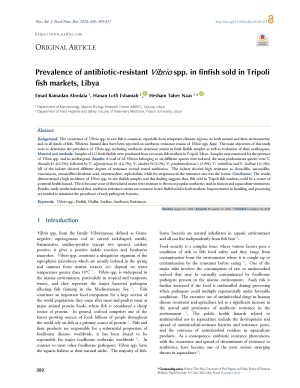Prevalence of antibiotic resistant Vibrio spp. in Finfish sold in Tripoli fish markets, Libya
Abstract
Background: The occurrence of Vibrio spp. in raw fish is common, especially from temperate climates regions, in both natural and farm environments, and in all kind of fish. Whereas, limited data have been reported on antibiotic resistance strains of Vibrio spp. Aim: The main objectives of this study were to determine the prevalence of Vibrio spp. including antibiotic resistance strains in fresh finfish samples as well as evaluation of their antibiogram. Material and methods: Samples of 122 fresh finfish were purchased from two main fish markets in Tripoli, Libya. Samples were examined for the presence of Vibrio spp. and its antibiogram. Results: A total of 68 Vibrio’s belonging to six different species were isolated, the most predominant species were V. fluvialis 45(66.2%), followed by V. alginolyticus 10(14.7%), V. cholera 9(13.2%), V. parahemolyticus 2(2.9%), V. vulnificus and V. hollisae 1(1.5%). All of the isolates showed different degree of resistance toward tested antibiotics. The isolates showed high resistance to cloxacillin, amoxicillin, vancomycin, amoxicillin/clavulanic acid, oxytetracylin, cephalothin, while for streptomycin the resistance rate was the lowest. Conclusion: The results demonstrated a high incidence of Vibrio spp. in raw finfish samples and this finding suggests that, fish sold in Tripoli fish markets could be a source of potential health hazard. This is because some of isolated strains were resistant to most popular antibiotics used in human and aquaculture treatments. Besides, study results indicated that, antibiotic resistance strains are common in raw finfish sold in both markets. Improvements in handling and processing are needed to minimize the prevalence of such pathogenic bacteria.
Full text article
Authors
Copyright (c) 2020 Authors

This work is licensed under a Creative Commons Attribution 4.0 International License.
-
Attribution — You must give appropriate credit, provide a link to the license, and indicate if changes were made. You may do so in any reasonable manner, but not in any way that suggests the licensor endorses you or your use.
-
No additional restrictions — You may not apply legal terms or technological measures that legally restrict others from doing anything the license permits.





